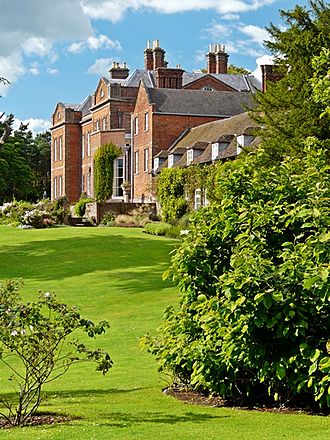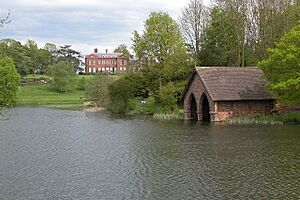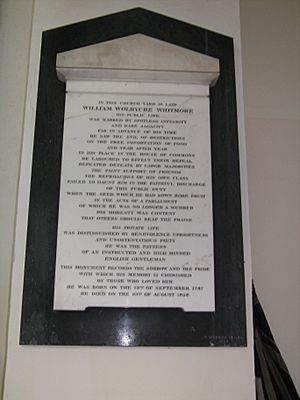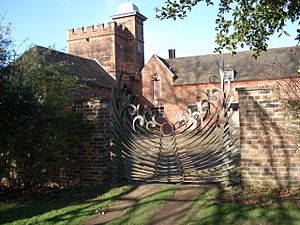Dudmaston Hall facts for kids
Quick facts for kids Dudmaston Hall |
|
|---|---|

Dudmaston Hall
|
|
| General information | |
| Location | Severn Valley |
| Town or city | Shropshire |
| Country | England |
| Coordinates | 52°29′48″N 2°22′31″W / 52.4966°N 2.3753°W |
| Completed | Late 17th century |
Dudmaston Hall is a beautiful country house from the 1600s. It is looked after by the National Trust. You can find it in the Severn Valley area of Shropshire, England.
Dudmaston Hall is close to the village of Quatt. It is a few miles south of the town of Bridgnorth, just off the A442 road.
Contents
History of Dudmaston Hall
Dudmaston Hall is a large country estate from the late 1600s. It shows what a traditional Shropshire estate was like. It includes the main house, lovely gardens, parkland, and woodlands. There is also a lake, farmland, and small cottages. For example, the village of Quatt was designed in 1870 for the estate's workers.
The Wolryche Family Connection
The Dudmaston estate has been connected to the Wolryche family since 1403. William Wolryche took over the estate when he married Margaret de Dudmaston. She was the daughter of the previous owners.
It is thought that a new house was built here in the 1500s. This was before the current building. Old maps show it as a strong, fortified manor house. The family likely earned money from raising sheep. Wool was very important in the economy back then.
The Wolryche family supported the Reformation and became strong Anglicans. They were also loyal to the King. Sir Thomas Wolryche (1598–1668) was the first of the Wolryche baronets. He became a baronet because he strongly supported King Charles I.
During the English Civil War, Sir Thomas raised soldiers for the King. He was put in charge of Bridgnorth Castle. In 1646, when enemy forces arrived, his soldiers set fire to the town. They then went into the castle but surrendered soon after.
Building the Current Hall
Sir Thomas's son, Francis, was the second baronet. After him, his fifth son, John Wolryche, took over the estate in 1668. John started building a new house nearby, but he died in 1685 before it was finished.
John's son, Sir Thomas Wolryche (1672–1701), continued the building work. He started a much bigger project. He replaced the old manor house with a new stone building. This is the main part of Dudmaston Hall today.
The architect was probably Francis Smith of Warwick. He designed a strong and well-built house. It was similar to Belton House in Lincolnshire. It has an H-shape layout with a large entrance hall. Building probably started before 1700. However, Sir Thomas died in 1701 before it was complete.
Sir Thomas's wife, Elizabeth Weld, managed the estate. Their son, Sir John Wolryche, took over in 1712. He spent a lot of money on gambling and hunting. In 1723, he drowned in the River Severn. He had no sons, and the estate had many debts.
The estate then went to Sir John's sister, Mary. She, her mother Elizabeth, and her uncle, Colonel Thomas Weld, lived at Dudmaston. Over the next 50 years, they worked hard to pay off the debts. They managed the estate very carefully.
- The Wolryche Family
-
An inscription at Bridgnorth Museum. It remembers Sir Thomas Wolryche setting fire to the town in 1646.
Developing the Gardens
Colonel Weld became the owner of Dudmaston. When he died in 1774, it went to a distant cousin, George Whitmore. George died soon after, and his nephew, William Whitmore (1745–1815), inherited it. William was a sailor who also inherited other large properties. This gave him money to fix up Dudmaston. He spent a lot on repairs and new furniture for the hall.
William Whitmore hired a famous gardener, William Emes, to design the grounds. Emes created a formal plan, but it was not used. Instead, William left his wife, Frances Lister, and his gardener, Walter Wood, to develop the gardens. Wood had worked on a "Picturesque" style garden before.
Walter Wood carefully changed the Quatt Brook, a small stream near the hall. He reshaped its path through the Dingle, a small, wooded valley. He created small cliffs, waterfalls, and rustic bridges. Frances then laid out winding paths and seating areas.
William Whitmore's son, also named William, added the old family name Wolryche to his own. He was a very energetic person. He had an active career as a politician who wanted to make changes. He also greatly changed the house and grounds.
Inside the hall, he added a beautiful staircase and new windows. He also built a large new dining room, which is now a modern art gallery. He completely reshaped the landscape to the west of the house. This area is the main view from the hall. The Big Pool was made by joining three small lakes. Terraces, steps, and walls were also built. To the south, he created the American Border. This area was first planted with rhododendrons. Today, it has many different Asian and American plants.
Features and Things to See
Dudmaston Hall has an amazing art collection. The National Trust says it is "one of Britain's most important public collections of modern art." It includes sculptures by Henry Moore and Barbara Hepworth. There is also a large collection of Spanish paintings and pottery from the mid-1900s. These were collected by Sir George Labouchère during his time as a diplomat.
Many activities happen on the estate. These include pig-farming and growing asparagus. Dudmaston also has a special way of "tushing." This is when a Fell Pony pulls logs in the woods where a tractor cannot go. Fell Ponies were originally used to carry lead from mines.
Notable People Who Lived Here
William Wolryche-Whitmore
William Wolryche-Whitmore (1787–1858) was an important politician who wanted to make reforms. He was the son of William Whitmore and Frances Lister. In 1810, he married Lady Lucy Bridgeman. The young couple traveled around Europe. They even visited Napoleon Bonaparte when he was exiled on Elba.
When his father died in 1815, William inherited Dudmaston. Five years later, he became a Member of Parliament for Bridgnorth. William quickly became a leading voice for liberal causes. He supported Parliamentary Reform and Catholic Emancipation. He spoke against the power of sugar plantation owners. He also looked forward to the end of slavery.
After the Reform Act 1832, he won the new parliamentary seat of Wolverhampton. He strongly believed in giving working-class people new chances through emigration. He was against using convict and slave labor. His last speech in parliament was about emigration to South Australia.
William also worked hard to end the Corn Laws. These laws made food expensive. He kept campaigning even after he left parliament. The Corn Laws were finally ended in 1846.
While still involved in politics, William updated the house and estate. He added new economic activities and improved conditions for his workers. This cost a lot of money. When he died, he left debts to his nephew, Francis Laing.
Charles Babbage
In 1814, Georgiana Whitmore married Charles Babbage. Georgiana was the daughter of William Whitmore and sister of William Wolryche-Whitmore. Charles Babbage was a pioneer in computing. He lived at Dudmaston Hall for long periods. He even designed the central heating system there.
His son, Henry Prevost Babbage, built an Analytical Engine Mill in 1910. This machine was on display at Dudmaston Hall until the 1980s. It was then moved to the Science Museum, London.
George and Rachel Labouchère
Rachel Hamilton-Russell (1908–1996) inherited the estate from her uncle, Geoffrey. She agreed that it should eventually go to the National Trust. Rachel had studied to be a botanical artist. She created an important collection of plant paintings and drawings at Dudmaston.
She met George Labouchère (1905–1999) during World War II in 1942. George was a diplomat. They married the next year. They agreed that Rachel would go with him on his diplomatic trips. Then, they would retire to Dudmaston together.
George's next job was in Stockholm. Rachel had to fly over the North Sea to marry him there. She even had to turn back once because German planes might have seen her. Later, George worked in China, Argentina, Austria, Hungary, and Belgium. He became a knight in 1955. In 1960, he became ambassador to Spain. In Spain, the Labouchères bought many artworks. These were made by artists who were against the government. This collection is now a big part of what you see at Dudmaston.
Uncle Geoffrey moved out in 1966. This allowed Rachel and George to retire to Dudmaston. The process of giving the estate to the National Trust was finished in 1978. However, they continued to live in the house and improve it. They built a large collection of modern art. They also kept items inherited from the Wolryche-Whitmores.
Rachel was very interested in the history of the Severn Valley. She worked to protect the area's industrial heritage. She was president of the Ironbridge Gorge Museum Trust for 14 years. She was active at Dudmaston almost until she died. She often talked with visitors.
Rachel and George did not have children. Rachel died in 1996, and George died three years later.
Rachel Labouchère wanted her relatives to always be able to live at Dudmaston. This was to keep it a family home, as it had been for over 850 years. She chose her second cousin, Col. James Hamilton-Russell. His family still lives there today.
See also
- Grade II* listed buildings in Shropshire (district) (A–G)
- Listed buildings in Quatt Malvern












